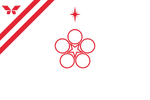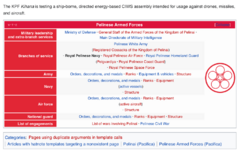Guide: How to TSPedia
This is a meta guide page dedicated to publishing good practices and standards for writing roleplay content on TSPedia. This page is intended to explain the basics of how to write pages, format them, and implement wikitext utility functions in them in order to maximize page quality.
This article contains basic information related to implementing wikitext formatting: while this cursory information is sufficient for most page writing activities on TSPedia, it is not intended to be a fully comprehensive guide for wikitext formatting. When advanced functionality or other wikitext material not covered in this page is deemed necessary for a given application, detailed documentation for it can found on Wikipedia help pages such as Help:Wikitext, Help:Cheatsheet, and Help:HTML in wikitext.
Formatting and style
Several formatting rules and recommendations for TSPedia pages exist to help increase readability and standardization.
Page naming and canon tags
- All roleplay-related TSPedia page titles have a suffix that denotes their canon; these are “abc (Pacifica)”, “def (A1-0)”, “ghi (Aurora)”, and rarely “jkl (Extra-canon)”. This suffix must always be present for roleplay pages where applicable, though meta pages such as the Roleplay in the South Pacific page are excluded.
- Only the first word and proper nouns should be capitalized in page titles; for example, a page should be titled “List of major cities in Nation” and not “List Of Major Cities In Nation”. Failure to do this may result in affected pages being difficult to find using TSPedia’s search bar due to the latter’s property of being case sensitive.
Section headers
- Page header/subheader structures have no clearly defined standard; if you are confused about what an appropriate header arrangement for a page would be, consider looking at TSPedia or Wikipedia pages with similar content. The primary rule is to start with the two-sign header ==Header== instead of =Header=, which is used automatically for page titles and looks confusingly similar to the two-sign header when it is used in the body of the page.
- Headers should not normally be made into links; in areas where it is deemed appropriate to add a high-visibility link to a main article or other particularly topic-relevant page at the top of a section, the {{main|YourPageHere}} and {{see also|AnotherPageHere}} templates should be used.
Text
Major style guidelines governing text are:
- The article title and any mentioned alternate names and languages should be bolded or italicized like as follows when stated in the first paragraph of a page: “The Abc (other language: Абв, Abv), also known as the Def or the Ghi, is text text text…”
- Outside of the above case, text should not be bolded. Italics should also be avoided except to denote book and film titles, ship names, and other cases as are similar to other style guides.
- Normal, non-guide wiki pages pertaining to things in roleplay canons are regarded as in-character writing; basic formal writing and wiki page writing guidelines thus apply as they would to comparable real-world sources. Pages should refrain from addressing the reader or speaking in the first person with words such as I, we, you, etc. Encyclopedic tone should be maintained; writing should be expository prose from a neutral perspective and should refrain from making statements in the persuasive or imperative tones.
Tables
| Tables | |||||
|---|---|---|---|---|---|
| Introduction and basics | |||||
TSPedia allows for the use of wikitables, which are a powerful and flexible way to display data, lists, pictures, and many other types of information that may be contained within a wiki page.
| |||||
| Colspan and rowspan | |||||
| Demo subheader 1 | Demo subheader 2 | Demo subheader 3 | |||
| Above is a demonstration of the type of formatting that is achievable with the colspan parameter of tables; similar formatting for rows is also available through the rowspan parameter. These commands allow for the creation of headers and subheaders that can be used, primarily, to group rows and columns of similar data together under a single label. They may be implemented by prefacing a cell with the text colspan="2" for columns and rowspan="2" for rows, with the “2” in each example replaced with the desired number of rows or columns to be spanned over. Take special note of the fact that the quotations used in the formatting must be straight quotations "", and not the normal quotations “” which are used by default on mobile keyboards; mobile users can access straight quotation marks in the same manner as other character variants. | |||||
| Colors and text alignment | |||||
| Colors can be used to give your table a theme, distinguish certain sections from each other, and otherwise break up the large gray blob that unformatted tables can display. Similarly, some cells may be better presented with different text alignment settings manually set. These properties are all set by prefacing the cell with the text | style:"background:#FFFFFF; color:#FFFFFF; text-align;left; text-align:up;", with properties removed or adjusted as appropriate. Colors can also be set by substituting hexadecimals with names from the extended HTML colors list shown here. | |||||
| Images | |||||
| Table cells can include images. these are implemented by simply placing the image link (such as [[file:Pelinese Flag.png|150px]]) into the cell field. The alignment of the image can be adjusted by the previously mentioned text-align property when it is applied to the cell; some examples of this are shown below. | |||||

|

|

| |||
Templates
Most types of roleplay content pages would benefit from at least one template. This is typically an infobox template, which are named according to the convention “template:infobox (type here)”; searching for templates requires the inclusion of the “template:” prefix.
Many template implementation copies on TSPedia lack documentation for their available fields and other information necessary for their use. In instances where this is the case, usage information can often be found by asking wiki writers, visiting the corresponding template page on Wikipedia (this one, for example), or (especially in the case of templates unique to TSPedia) by finding a TSPedia page that implements it and copying the template text.
Country data templates
Many pages on TSPedia, especially list page like this, contain a specific template called a flag template or a country data template. This is a common template which can be used to automatically add links and small-sized, inline flags like these:
The easiest way to add a country data template for your nation is to create a page named “template:country data ((nation name here))”, copying the text from another country data template, and editing parameters such as the name and flag picture links as necessary.
Infoboxes
Most common page types benefit greatly from being anchored by a specific type of sidebar template called an infobox. These templates are boxes that function like the abstract of a paper: they provide an easy way for writers to quickly communicate a summary of key statistics and other information to readers, which becomes increasingly important with larger, more detailed pages. A variety of infoboxes tailored to different page subjects can be found on TSPedia by searching for them, and more are occasionally added on a by-request basis.
List templates
Some infobox templates are incompatible with list formatting methods like “{{*}}” (which appears as a • ) and “<br>” (which produces a line break). For instances where this is the case, templates such as {{bulleted list}}, {{ordered list}}, and {{plainlist}} may be used instead. These have display styles, as shown below. For implementation details and more style options, refer to this Wikipedia page.
| Plain list | Bulleted list | Ordered list (decimal) |
|---|---|---|
|
|
|
Connectivity

If a roleplayer writes a wiki page and nobody finds it to read it, does the page really exist? Making sure that your page can be found is an important part of making it useful; for this purpose, connectivity aids like links, categories, and drop-down boxes exist.
Links
There are two maintenance pages on TSPedia which list pages that either are not linked to or do not link to anything; these are called orphaned pages and dead-end pages, respectively, and can be found by visiting the “special pages” section linked on the left-hand sidebar of TSPedia. Do not, under any circumstances whatsoever, add entries to this list; every page in TSPedia should link to and be linked to by other pages. Being linked to is especially critical for the visibility of highly specialized pages, such as “Orders, medals, and decorations of xyz”, which are unlikely to be specifically searched for by name.
Links in roleplay pages typically go to TSPedia, like this, or to Wikipedia, like this. Links are case-sensitive aside from the first letter, in a similar manner to the search box; links like Pacifica (Pacifica) will function, as will pacifica (Pacifica), but Pacifica (pacifica) will not. Adding a hashtag/pound sign to a link will cause it to point towards a specific header of a TSPedia or Wikipedia page as applicable, such as in the case of Pacifica (Pacifica)#Atmosphere.
Links that lead to nonexistent pages are red; clicking a red link will prompt you to create the page. Red links are very common throughout TSPedia as a way to indicate that a particular page needs to be made, or that it is planned to be created in the future.
Categories
Category tags and category pages are a helpful method of linking together pages with a common theme or subject. Adding a category tag to a page and creating the red-linked page that it links to will automatically generate a list of all pages with the category tag on them; this provides a central directory where all pages pertaining to a specific topic can be viewed, as well as an up-to-date counter displaying the amount of pages in that category.
While not all potential topics warrant having a category created for them, consider making categories for topics that currently possess a set of 8 or more pertinent pages. Typical candidates for categorization include roleplay nations with high wiki presence (e.g. the Anserisa, Pelinai, and Sedunn categories) and particular classes of pages with similar purpose (e.g. the “collaboration stubs (Pacifica)” category).
Drop-down boxes
Drop-down boxes are a specialized type of template and a powerful tool to organize particularly large systems of wiki pages centered around a common subject; the ability to create subsections within them makes it easy to organize large blocks of page links, and readers can more easily navigate such arranged repositories as well. They should generally be reserved for page systems numbering roughly 10 to 15 or more entries, and should be placed at the bottom of a page.
Sidebar boxes
The sidebar box is a convenient way to add a link block to the top of a page in an aesthetically pleasing manner. They are placed inside the article instead of at the bottom like a drop-down box; this increases their visibility in comparison to drop-down boxes, but can also visually clutter the top of the page if the sidebar box is particularly large and/or placed in combination with a large infobox.